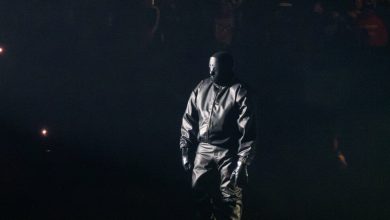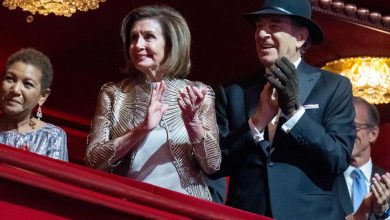Ready When You Are, Terminal C Is Now an Art Destination

When Delta Air Lines’ Terminal C at La Guardia Airport opens to the public on Saturday, New York will get not only a gleaming new transportation hub but also a significant art destination.
“Airports are gateways to a region — travelers should know where they are,” said Rick Cotton, the executive director of the Port Authority of New York and New Jersey, which operates La Guardia. “Public art is at the core of that aspect of building a new civic structure.”
Large-scale permanent installations by Mariam Ghani, Rashid Johnson, Aliza Nisenbaum, Virginia Overton, Ronny Quevedo and Fred Wilson — all artists living and working in New York — are poised to become new city landmarks throughout the terminal.

The new works were commissioned by Delta in partnership with the neighboring Queens Museum and are part of a $12 million art program throughout Terminal C.Credit…Justin Kaneps for The New York Times
The new works, commissioned by Delta Air Lines in partnership with the neighboring Queens Museum and part of a $12 million art program in Terminal C, join a constellation of other projects at La Guardia.
In Terminal B, four site-specific pieces by Jeppe Hein, Sabine Hornig, Laura Owens and Sarah Sze were commissioned by La Guardia Gateway Partners with the Public Art Fund in a $10 million investment unveiled in 2020. A restored 1942 mural by James Brooks in Terminal A nods to the heyday of Works Progress Administration artists employed in the service of grand infrastructure projects. And a soaring 40-foot-high Richard Lippold sculpture, which hung at Lincoln Center for decades, will become the centerpiece of an atrium to be completed this year.
As the largest carrier in New York, employing 10,000 people in the area prepandemic (and now back up to over 9,000), Delta wanted the artworks in its terminal “to be New York-centric and reflect the diversity of our company,” said Ryan Marzullo, a managing director with the company who is overseeing the $4 billion Terminal C project, now 80 percent finished.
For each of the six artists chosen by the Delta team from dozens initially presented by the Queens Museum, it’s been an opportunity to push their practices in terms of scale and experimentation, according to the museum’s president and executive director, Sally Tallant. “All these works are very rooted in what it means to live in New York,” she said.
Virginia Overton
Known for her sculptures made from recycled materials that respond directly to architectural spaces, Virginia Overton has installed a dozen large and glowing gem shapes crafted from New York City skylights that dangle at varying heights through a three-story atrium in the arrivals and departures hall.
“I wanted to make something that was indicatively New York,” she said. Overton, who grew up in Nashville, remembers her father’s stories of flying in low over New York on business trips and looking down on buildings with dramatic skylights. These days, in her Brooklyn studio, she often finds herself staring up at the skylights. “When you’re inside a building, that’s where you look up and move from ground to sky, which felt like the right gesture for the airport,” she said.
Each of her 12 sculptures contains large panes of old-fashioned security glass set into geometrically faceted metal armatures, up to nine feet long, that Overton dragged from salvage shops and sometimes the garbage. She then replicated the mirror half of each skylight to create jewel-like forms that are lit from within. Floating sideways, these gritty and magical beacons come into focus as you approach. “Hopefully it will engage people who’ve just flown in to New York and recognize the skylights from some of the buildings around here,” said Overton, “and encourage people to look up and down.”
Rashid Johnson
Rashid Johnson is widely recognized for his multidisciplinary workthat summons the collective anxieties of our times. In his mosaic “‘The Travelers’ Broken Crowd,” 60 agitated faces loom in rows across a 45-by-15-foot expanse on a wall visible from three levels of the arrivals and departures hall.
“Travel is such an interesting and complicated and beautiful and frustrating event, whether you think of it for the purpose of bettering oneself or the substantial refugee crisis right now,” said Johnson. “These characters that I call ‘Broken Men’ are witnessing the travelers and being witnessed by the travelers. It kind of feels like all of us.”
Within the repetition of his simplified geometric faces reduced to wide eyes and clenched mouths andpieced together largely from black-and-white ceramic fragments, Johnson has achieved glorious variation by overlaying passages of brightly colored tiles, hand-painted gestures in oil stick, black soap and wax, clusters of oyster shells, and pieces of mirror whacked with a hammer.
“The gymnastics of the scale definitely pushed me to have to challenge myself physically as far as my interactions in the work,” said Johnson, who moved here from Chicago and lives in Manhattan and Bridgehampton, N.Y. “I loved the idea that it’s a permanent installation as well, something you can use as a marker for where you are.”
Ronny Quevedo
For a decade, Ronny Quevedo has reconfigured gymnasium flooring to explore sites of convening and sport, which he views as especially important to immigrant communities. For the first time, the artist has fabricated a wooden gym floor at full scale and from scratch, now mounted on a wall of Delta’s arrivals and departures hall. Its brightly painted lines of play are fragmented and rearranged into a dynamic abstract composition.
“This urban environment we live in is always moving into new directions,” said Quevedo, who grew up in the Bronx and accompanied his father, who played professional soccer in Ecuador, to the games he refereed every weekend at schools and parks throughout the city. For the artist, the gymnasium flooring is an opportunity “to represent the multiple intersections and communities and different experiences one can get from New York,” he said, “and the role of play in developing one’s own identity.”
Within his reimagined floor diagram on Delta’s wall piece, Quevedo superimposed constellations of stars applied in layers of gold and silver leaf. “It’s a way of pairing that movement of migration with that movement of the cosmos,” he said. “This sense of struggle and resiliency is not just focusing on victimization but on re-envisioning oneself.”
Mariam Ghani
With her first tile mosaic, mounted in Terminal C’s baggage claim area, the multimedia artist Mariam Ghani has created a portrait of New York based on a data visualization of the more than 700 languages and dialects spoken in the area.
“The Worlds We Speak” presents six planetary clusters standing in for the city’s five boroughs plus the tristate area. These spheres contain a multitude of smaller circles in a spectrum of vivid colors, each representing a linguistic community and engraved with the name of that language in its own script.
“New York is the most linguistically diverse city in the world and every language is a whole way of seeing the world,” said Ghani, an Afghan American born in New York. She used data collected in the last census as well as the Endangered Language Alliance. “The airport is a point through which all this traffic proceeds and that brings us all this wealth of knowledge,” she said.
For Ghani, the most challenging part of the project was spelling each of the languages correctly. “It was the most massive copy-editing job you can possibly imagine,” Ghani said, hoping people will enjoy finding their native language while waiting for their baggage to arrive. “Ceramics are permanent. You can’t go back and fix it later.”
Fred Wilson
The artist Fred Wilson often reframes cultural objects and mines layers of meaning in the color black. For his La Guardia piece titled “Mother,” he has combined starlight globes with black oceans with his signature black drip-shaped sculptures. Supply chain issues delayed production, so later this summer, 12 globes ranging from 18 inches to 11 feet in diameter will be suspended in a three-story atrium of the arrivals and departures hall amid a cascade of 24 giant black drips measuring up to six feet long.
Wilson, a lifelong New Yorker, first envisioned this piece on a night flight. “It was utter blackness and occurred to me looking down how fragile our world is,” said Wilson, whose shower of drips around the globes could read as atmospheric or extractions of oil or tar from the earth, or teardrops. “Certainly the ecology and the planet’s survival is forward in this piece,” he added, an aspect new to his work.
All of the globes will be hung on different axes, to be viewed from varying perspectives, with each of the land masses painted a different color without countries or borders. It’s the first time the artist has hand-painted his work.
“My mother was a painter and maybe because of that I steered clear of it,” he said. “But I’ve really enjoyed working on these.”
Aliza Nisenbaum
In her installation forDelta, the painter Aliza Nisenbaum has commemorated a cross-section of Terminal C’slabor force in a monumental group portrait.
“I was interested in what it takes to run an airport and talking to the actual people who are the first faces that people meet when they arrive,” said Nisenbaum, who grew up in Mexico City and is now based in Queens. From a large pool of Delta and Port Authority employees she interviewed, the artist selected 16 whose stories of service inspired her, including a security guard, a taxi dispatcher, a janitor, pilots and flight attendants.
She painted each one from a combination of Zoom interviews and photographs and wove the individuals into a composite. Her painting is being translated into a mosaic, her first.
A vinyl reproduction of the finished painting now hangs in Concourse F until her future mosaic can be installed in a concourse yet to be built.
It is the only artwork in Delta’s terminal behind a security checkpoint and Marzullo, overseeing construction, feels that’s appropriate. “Aliza’s piece is not just for our customers, it’s also for all the employees it takes to run this little city,” he said. “It’s so that everyone who’s working back there can be reminded of their importance.”





